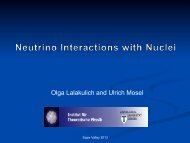HELIOS and the radioactive beam program at Argonne
HELIOS and the radioactive beam program at Argonne
HELIOS and the radioactive beam program at Argonne
You also want an ePaper? Increase the reach of your titles
YUMPU automatically turns print PDFs into web optimized ePapers that Google loves.
<strong>HELIOS</strong> ... 7<br />
Fig. 5. The energy of protons, E p, is plotted vs. z p for <strong>the</strong> d( 28 Si,p) reaction. The<br />
diagonal traces represent st<strong>at</strong>es in 29 Si, whereas horizontal lines arise from a shortlived<br />
α-contamin<strong>at</strong>ion in <strong>the</strong> chamber. Horizontal gaps of about 1 cm between<br />
<strong>the</strong> detectors are evident, <strong>and</strong> a proton background from fusion-evapor<strong>at</strong>ion on<br />
<strong>the</strong> carbon in <strong>the</strong> CD 2 target is seen.<br />
reactions with heavy <strong>radioactive</strong> <strong>beam</strong>s, such as those becoming available from <strong>the</strong><br />
CARIBU injector <strong>at</strong> ATLAS in <strong>the</strong> near future.<br />
7. Conclusions<br />
In this paper we have given a historical perspective on <strong>the</strong> <strong>radioactive</strong> <strong>beam</strong> <strong>program</strong><br />
<strong>at</strong> ATLAS. This work has been ongoing for over a decade, starting with <strong>beam</strong>s<br />
obtained from rel<strong>at</strong>ively long-lived activities produced <strong>at</strong> o<strong>the</strong>r acceler<strong>at</strong>ors, <strong>and</strong><br />
continuing with a very productive <strong>program</strong> with in-flight produced <strong>radioactive</strong>, but<br />
rel<strong>at</strong>ively light, <strong>beam</strong>s th<strong>at</strong> have been used mostly for nuclear astrophysics studies.<br />
With <strong>the</strong> new CARIBU injector, which will be commissioned in <strong>the</strong> summer/fall of<br />
2009, <strong>the</strong> range of <strong>radioactive</strong> <strong>beam</strong>s will be exp<strong>and</strong>ed to include very neutron-rich<br />
fragments from spontaneous fission of a strong, 1 Ci, 252 Cf source. In order to<br />
use <strong>the</strong>se <strong>beam</strong>s for transfer reaction studies, a new type of spectrometer has been<br />
built, which is ideally suited for <strong>the</strong> study of such reactions in inverse kinem<strong>at</strong>ics. It<br />
is expected th<strong>at</strong> <strong>the</strong> CARIBU injector <strong>and</strong> <strong>the</strong> <strong>HELIOS</strong> spectrometer will allow for<br />
a wide range of detailed studies of <strong>the</strong> nuclear structure in <strong>the</strong> neutron-rich region<br />
of heavy nuclei from CARIBU as well as nuclear astrophysics studies with <strong>beam</strong>s<br />
produced via <strong>the</strong> in-flight method.





